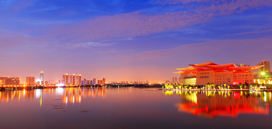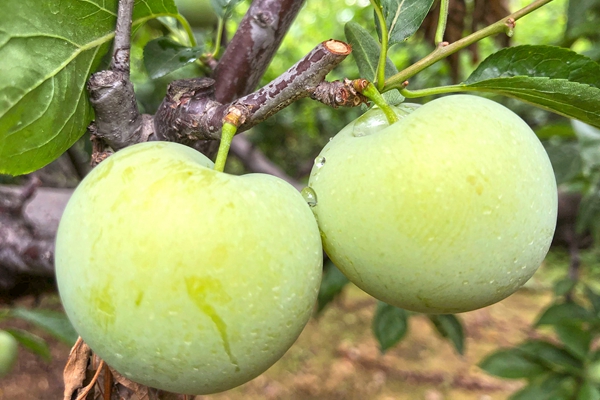Pingjiang historic quarter
Updated: 2012-03-09
The Pingjiang Historic Quarter is located in the northeastern part of old Suzhou on a 116.5-hectare area, with the outer ring river to the east, Lindun Rd to the west, Ganjiang Rd to the south, and East Baita Rd to the north. The area has a 2,500-year history and the best-preserved cultural-protection zone of old Suzhou.
The Pingjiang Quarter is part of the historic, cultural area of old Suzhou and has been in existence for 1,000 years, maintaining the style of the Song Dynasty. It is a portrait of “water and land, and rivers adjacent to the streets,” and a good example of the waterside towns south of the Yangtze River with their “small bridges over flowing streams, and whitewashed walls and black tiles”.
Its cultural heritage and landscape are exemplified in places such as Ouyuan Garden, a world cultural heritage site, and the Kunqu Opera Museum (Quanjin Guild Hall), a cultural heritage exhibit of Kunqu Opera. There are nine cultural relics protection units, 43 pieces of architecture under protection, and a multitude of early architecture, classical bridges, wells, and memorial archways. The ruins of the old town walls are clearly visible. Throughout history, many literary scholars, high officials, and members of the nobility lived in the quarter. It is an open district consisting mainly of residential buildings and its true value lies in the traditional style of living. The quarter is a living record of Suzhou’s 2,500 years of history and is not just for sightseeing, but also a place where you can witness history and traditional culture in action.
In 1986, the State Council approved a plan for protecting the Pingjiang quarter and, in 2002, the municipal Party and municipal government, while hosting the 28th World Heritage Conference, used the opportunity to experiment with a project to retain the old features of Pingjiang Rd and the environment.
The government approved a Protecting and Improving the Pingjiang Historic Quarter of Old Suzhou project proposed by Ruan Yisan, a Tongji University professor and prominent cultural protection expert. This opened a new chapter in the protection of the Pingjiang Historic Quarter and called for maintaining the old town’s style, making a display of the traditional features, beautifying the environment and landscape, and maintaining the culture, all in accordance with a principle of “repairing the old as the old, step by step”. The Suzhou government got to work on projects to renovate housing, dredge the rivers, repair piers, repair revetments, plant trees, re-pave roads, bury pipelines, install digital monitoring devices, and improve the landscape and scenery.
The government gave priority to culture, and made an effort to develop recreational tourism and had some success in attracting investment and promoting the tourism industry. It added hotels, galleries, clubs, and café bars in the quarter, with the idea if integrating the modern and the historical.
In 2005, the United Nations Educational, Scientific, and Cultural Organization gave the Pingjiang historic quarter an Asia-pacific cultural heritage protection award and the panel of judges said that, “The project is a good example of city rejuvenation. It has been an outstanding performance in protecting historical heritage, maintaining social structure, and implementing an operation mode. It proves that historic areas can have sustainable development.”
In 2009, Pingjiang Rd joined the Ministry of Culture and State Administration of Cultural Heritage’s first top 10 list of Chinese historic and cultural streets. The organizing committee said that, “Over a 2,500-year period, old Suzhou has kept its site and basic pattern, making it a living sample of classical Chinese towns. Pingjiang Rd is the best-preserved quarter in old Suzhou and the epitome of a classical town. Pingjiang Rd has basically maintained the urban structure displayed by the “Picture of Pingjiang” of the Southern Song Dynasty, and the “General Map of Suzhou’s Urban Waterways” of the late Ming Dynasty, since the Tang and Song and it has maintained great vitality.”
Getting there: Bus Take tourist bus No 5 or buses No 60, 900, 9, 514 or 112 to Xiangmen station, then take tourist bus No 5 or 2, or bus No 202, 204, 309 or 923 to the eastern stop at Guanqian St, Cufang Bridge, then take bus No 305 or 301 to the Pingjiang Rd stop.
Driving:
From Shanghai: Take the Shanghai-Nanjing expressway to the Suzhou exit, get on the eastern ring road and turn left to Ganjiang Rd, then get Pingjiang Rd.
From Nanjing: Take the Shanghai-Nanjing expressway to the Suzhou exit, get on the eastern ring road, turn left to Ganjiang Rd, take Pingjiang Rd.
From Hangzhou: Take the Suzhou-Jiaxing-Hangzhou expressway to the Shanghai-Nanjing expressway and take a left to Ganjiang Rd, look for Pingjiang Rd.
Tel:0510-81178873
E-mail:haiyulu@163.com


